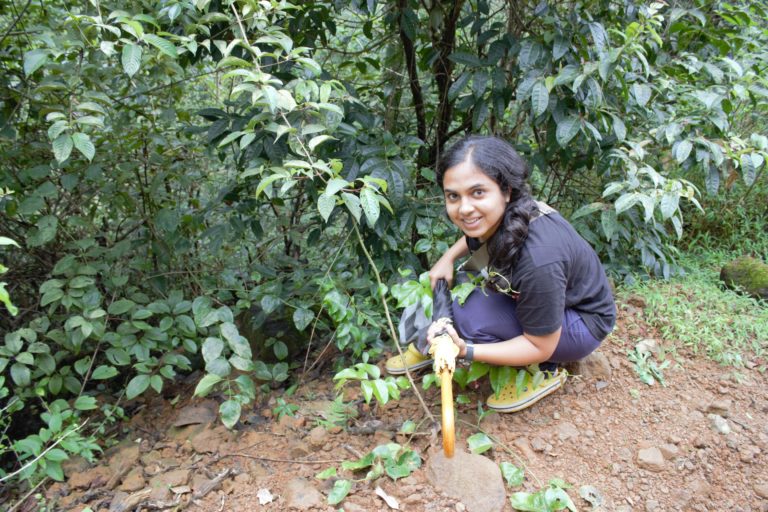- Sri Lanka and India have been intermittently connected for millions of years, leading to some similarities in habitats and several organisms that are common between the two countries. Yet today Sri Lanka is an island, which has led to the evolution of some unique endemic species on the island.
- Researchers set out to understand how the island’s biodiversity might have been influenced by its shared geological history with India, by studying the evolutionary history of the common house gecko and its close relatives in both places.
- The study showed that geckos in the dry zone habitats of Sri Lanka were also found in Peninsular India and had probably reached the island whenever it was connected to the larger Indian landmass. But endemic species on the island were restricted to the small wet zones.
Most households in South Asia would have at some point given shelter to the common house gecko Hemidactylus frenatus. This pale colourless reptile inhabiting the corners of our ceilings, has inspired several ancient myths and superstitions that persist to this day. And now scientists are hoping that the species and its relatives, other Hemidactylus geckos, will help tell an even more ancient story – that of the origins of the Indian sub-continent and the island of Sri Lanka.
Though separated by the Indian ocean, Peninsular India and Sri Lanka share much of their natural heritage. From massive elephants to tiny rodents, many creatures that are Indian are also Sri Lankan. But there are also differences. Like other island ecosystems, Sri Lanka is also home to several endemic species, found nowhere in the world.
What causes this dichotomy?
“One way of addressing this question is by understanding how species assembled in a particular region over evolutionary timescales,” said Aparna Lajmi, an evolutionary biologist at the National Centre for Biological Sciences (NCBS), Bangalore.

There are two common theories for how any ecosystem develops its set of species.
One is by dispersing from the place of origin. Plants and animals constantly look for ways to move across the landscape and colonise new regions but, as Lajmi points out, this is dictated by whether they can reach the place. “If it is very accessible, assembly of species is generally through dispersal of organisms from neighbouring regions,” she said. For instance, lions are believed to have originated in Africa about one million years ago and spread to Europe and Asia because these continents were connected by land.
Sometimes organisms cannot move across landscapes because of some barrier – such as oceans for terrestrial animals or a vastly different habitat or climate in which the animal cannot survive. These organisms are isolated. Over time they develop adaptations to take advantage of new environments or resources within their current habitat. Because they are not able to move across – and spread their genes and new adaptations across a larger landscape – these animals become unique, endemic species restricted to those landscapes.
Dispersal or diversification?
So, the question for Lajmi and her colleagues was — which of these theories applied to Sri Lanka, especially for the Hemidactylus geckos?
Given that it’s an island, it might seem obvious that at least geckos in Sri Lanka must have evolved through diversification, with the Indian Ocean preventing them from spreading towards India or even further towards Africa or southeast Asia. But here’s the nub of it all: Sri Lanka has spent more time connected to India than separated.
About 175 million years ago, Peninsular India was part of the supercontinent Gondwanaland along with Madagascar which was an extension of India’s south-western side. About 90 million years ago, India broke off from Gondwanaland and made its way towards Asia. Sri Lanka was part of the fragment. When about 45 million years ago the fragment collided with the Tibetan Plateau, raising the Himalayas from the dead Tethys sea and forming the Indian sub-continent, Sri Lanka was still connected.

Twenty five million years ago, sea levels rose and the newly formed Indian Ocean crept in on all sides submerging a bit of Southern India, creating in the process a teardrop-shaped island. But every few thousands of years, climate would change again, the ocean would retreat, and the island would become part the mainland once again.
“As a result,” explained Lajmi, “Sri Lanka and Peninsular India have been intermittently connected through land connections.”
Because of these intermittent connections, animals like Hemidactylus geckos have had plenty of opportunity to move from India to Sri Lanka or vice versa, explained Praveen Karanth, Lajmi’s doctoral advisor at the Indian Institute of Science and fellow researcher. “Therefore by and large the Sri Lankan biota is a subset of what we find in India,” he said.
But Karanth points out that Sri Lanka has an independent biological history as well, adding, “After all, currently it’s an island; and it exhibits some features of an island which makes it interesting.”
This where the geckos come in. Lajmi explains that gecko species of the Hemidactylus group served as a useful model to understand the journey of Sri Lanka’s biodiversity, because they were common across Peninsular India and Sri Lanka. “While both these regions have endemic species, there are also species that are widely distributed in both these areas,” she said.
For instance, of the seven species of Hemidactylus geckos found in Sri Lanka, four including the house gecko are also found in Peninsular India. Three, the spotted giant geckos Hemidactylus hunae, the Kandy leaf-nosed gecko Hemidactylus depressus and the Kandy house gecko Hemidactylus pieresii are endemic to the wet rainforests of the Sri Lankan highlands. The Kandy house gecko Hemidactylus pieresii was only recently discovered to be an endemic species and was not studied by the researchers.

How are some species so widespread while others are restricted to the island? Did animals travel from the larger mainland, in this case India? Or did years of isolation create species unique to the island?
The answer might be both. By studying the genes of these gecko species, the researchers built a profile of when each species evolved, whether they originated in India or in Sri Lanka and the habitats they occupied.
They compared this information to the geological events in this region at the time, including how often the two countries were connected and how the climate changed during the evolution of these species.
Shrinking rainforests isolate geckos
All seven species in Sri Lanka originated in India and then moved towards the island. The earliest arrivals were the two rainforest species, the spotted giant gecko and the Kandy leaf-nosed gecko. These two species settled in the region right after the Indian fragment joined Asia.
The four gecko species common to India and Sri Lanka arrived on the island during different times, but always when water levels subsided and the two countries were connected once again. The researchers speculate that some of the species, like the house gecko might have accidentally travelled with the humans moving into Sri Lanka. Importantly even today, all four species are found in similar habitats in both regions – in scrub, rocky outcrops and grasslands of the dry zone.
Previous studies have found that in the wet zone in Sri Lanka, organisms seemed to have evolved because of isolation. “The pattern seen in Hemidactylus is that the wet zone Hemidactylus of Sri Lanka are endemic, while the dry zone species are shared between India and Sri Lanka,” said NCBS researcher Lajmi. This pattern implies that geckos in the dry habitats in Sri Lanka were more connected to India, lending credence to the theory of dispersal in these parts.
But why were the wet rainforests of Sri Lanka isolated enough for the geckos to evolve into unique species? “This we think has to do with the history of the dry and wet zone in this region,” said Lajmi.
When the India plate was slowly making its way to Asia, the global climate was warm and humid all year around, ideal for wet forests. But the rise of the Himalayas lead to more distinct dry and wet seasons. The dry season also became longer, possibly because the drop in temperature led to less moisture in the atmosphere and lower spells of rain, causing rainforests of India and Sri Lanka to shrink. Remnants of these forests are what we know today as the Western Ghats in southern India and the Central Highlands in Sri Lanka.

“We think that before the drying, rainforests of India and SL [Sri Lanka] were better connected leading to the dispersal of wet habitat species,” said Lajmi. The shrinking of the rainforests meant that even when India and Sri Lanka were connected, the wet forests of the spotted gecko and the Kandy leaf gecko were not.
These geckos were possibly isolated enough to become endemic species. “On the other hand, with the drying, the dry habitats were now better connected which might have led to dispersal of more dry habitat species more recently,” she added.
“It is an elegant piece of work and nicely complements what is known of the biotic connection between India and Sri Lanka,” said Rohan Pethiyagoda, a taxonomist at the Australian Museum, Sydney, not connected to the study. Pethiyagoda who extensively studied freshwater fish species of Sri Lankan rainforests points out that this pattern has been seen with some other taxa in the region. “There is a trenchant divide between the biotas of the wet and dry zones of both southern India and Sri Lanka.”
He also argued that the spread of dry zone effectively prevents any rainforest adapted species from moving across. Thus, “literally dozens” of animals and plants that occur in southern India and the Western Ghats are absent from Sri Lanka. “Climate is a great isolating mechanism,” he concluded.
For Lajmi, the study’s most important take way is the potential for using the evolutionary history of an organism to get a glimpse of the larger history of the landscape. “We know little [about the] details and extent of these paleo changes, but hopefully studying different organisms in this framework along with paleo-climatic and paleo-vegetation studies will help build a more nuanced picture of the past,” she signs off.
CITATION:
Lajmi, A., Bansal, R., Giri, V., & Karanth, P. (2018). Phylogeny and biogeography of the endemic Hemidactylus geckos of the Indian subregion suggest multiple dispersals from Peninsular India to Sri Lanka. Zoological Journal of the Linnean Society.
Banner image: The termite hill gecko, Hemidactylus scabriceps, found in the dry plains habitats of both Southern India and Sri Lanka. Photo by Sheshadri K.S./Wikimedia Commons.













